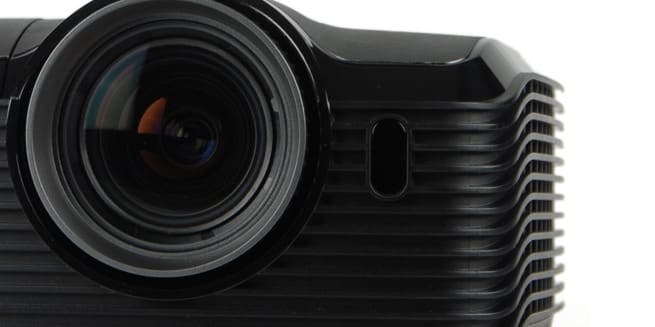Pros
Cons
Introduction
Overview
The ViewSonic Pro8200 is a bit too boxy to be attractive, but for a mid-range model, it will get the job done.
Front
{{section_header}}{{section.name}}{{/section_header}}
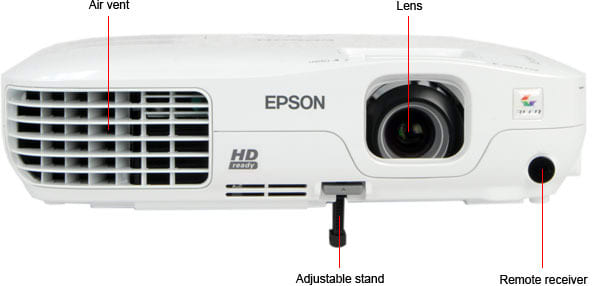
Back
{{section_header}}{{section.name}}{{/section_header}}
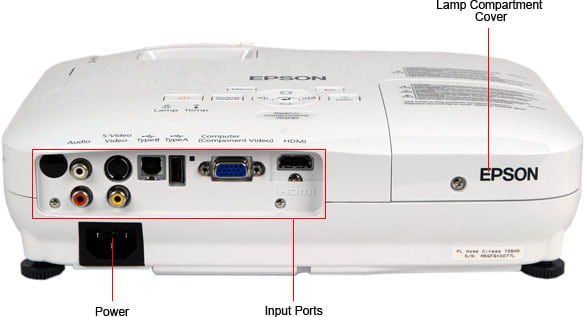
Sides
{{section_header}}{{section.name}}{{/section_header}}
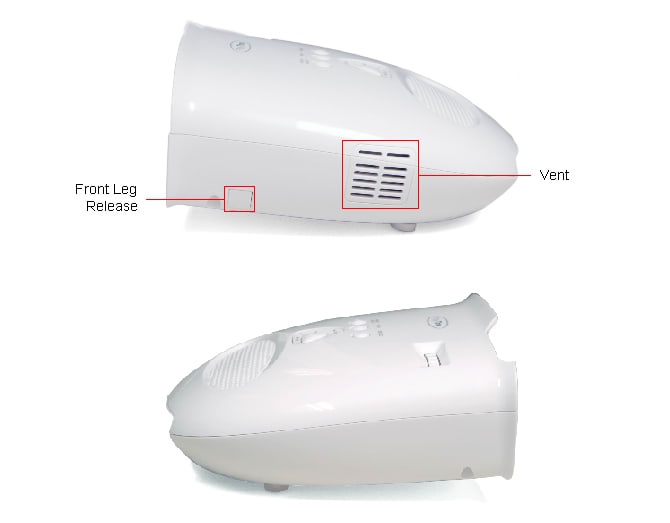
Top/Bottom
{{section_header}}{{section.name}}{{/section_header}}
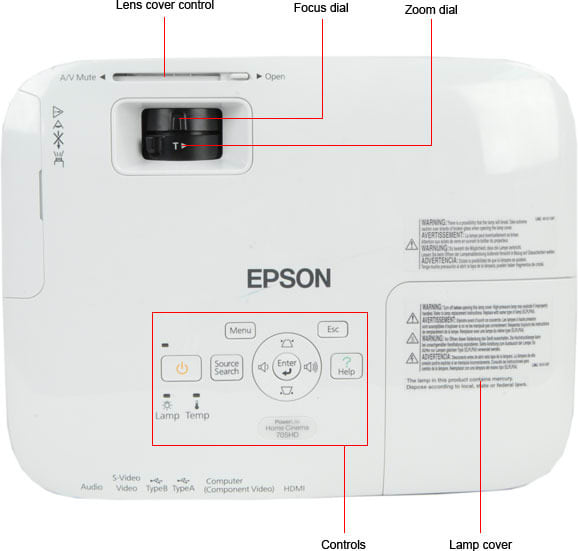
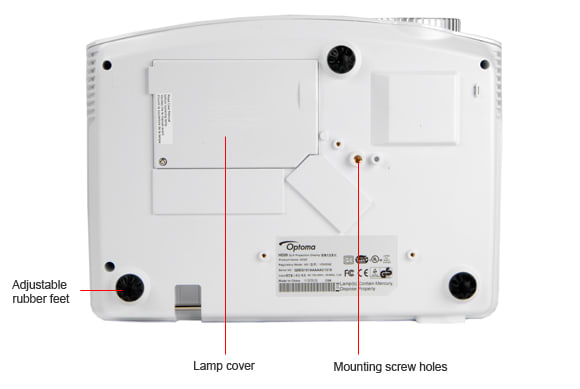
Stand/Mount
{{section_header}}{{section.name}}{{/section_header}}
The {{product.name}} has two adjustable feet in the back, and one in the center of the front. The foot in the front pops down when you depress a button release there, and the ones in the back are like screws, their height adjustable by tightening or loosening them. You may also permanently mount this projector using the screw holes on the bottom.
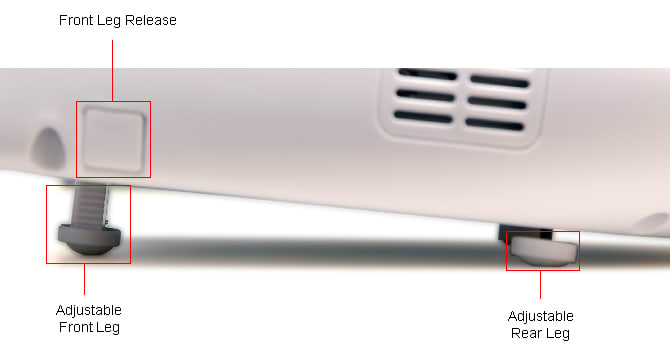
Lamp
Remote Control Tour
{{section_header}}{{section.name}}{{/section_header}}
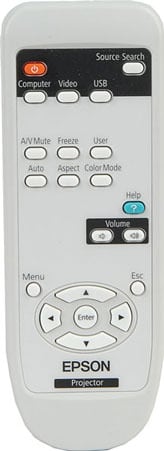
The small remote control of the 705HD
In the Box
{{section_header}}{{section.name}}{{/section_header}}
The {{product.name}} comes with a couple of cables to get you connected right away. In the box were the following:
-Carrying case
-Remote control (no batteries)
-DVI cable
-HDMI cable
-Lens cap and strap
-Warranty documents (no paper manual)
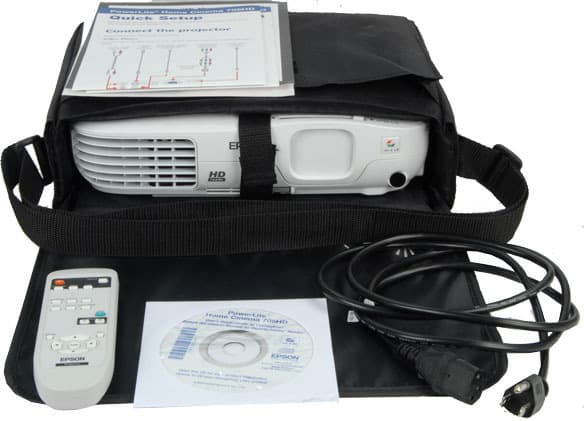
The 705HD comes with a carrying case, manuals, power cable and remote
Setup Assistance
{{section_header}}{{section.name}}{{/section_header}}
There is no full-auto setup mode on the {{product.name}}. There is an auto keystone function, the default setting has it turned on. In the end, we chose to override the auto keystone setting because it was not quite accurate.
Otherwise, the {{product.model}} was much like a normal projector: not the easiest device to setup for a perfect picture.
{{product.raw_scores['Setup']}}
Aesthetics
{{section_header}}{{section.name}}{{/section_header}}
The {{product.name}} is a boxy affair, with many ridges and air vents along the sides. It is not the prettiest projector we have seen recently. There are no rounded edges, or attractive veneer, looking much like other Viewsonic models. It is a bit larger than some of the sleek, compact models we have reviewed recently.
Peak Brightness
{{section_header}}{{section.name}}{{/section_header}}
At its brightest, the {{product.name}} is a little below average for competing projectors in the price range, at least among what we've tested so far. This will hurt its ability to be used in a bright room for presentations or in a classroom setting. Generally, we calibrate projectors in theater mode because it produces the best set of colors, where a presentation mode like Brightest will blow out the color performance. Too much light does not seem to be a problem here, but the colors were still best in Theater mode, optimized for watching movies in a light-controlled home.
{{image_chart title="Peak Brightness", attachment="Peak Brightness Graph"}}
Though we recommend theater mode, we tested the peak brightness in brightest mode. You can see that other projectors in a similar price range can get much brighter than the {{product.name}}, but that it is not the dimmest bulb on the market.
{{image_chart title="Peak Brightness", attachment="Peak Brightness Comparison Graph"}}
Tunnel Contrast
{{section_header}}{{section.name}}{{/section_header}}
Projectors tend to have trouble maintaining deep black levels as areas of black on the screen decrease. You can see that the black level rises steadily as the areas of black decrease, getting as bright as 10 cd/m2 at 5% black. These are not the type of numbers we see on high-level projectors that can maintain a consistent black level. This Viewsonic has a big problem with consistent black levels that is unfortunately average for mid-tier projectors.
{{image_chart title="Tunnel Contrast", attachment="Tunnel Contrast Graph"}}
Uniformity
{{section_header}}{{section.name}}{{/section_header}}
The {{product.name}} projects a picture with the brightest spots landing in the center of the screen. The edges and the corners taper off rather significantly in brightness. Some of the corners are about 40% dimmer than the center. For a picture that is already not as bright as the competition, we would hope to see better brightness consistency across the screen. Dimming this significant on the edges and the corners is only going to further obfuscate the picture in a meeting room with plenty of windows or a bright classroom setting.
{{image_chart title="Uniformity", attachment="Uniformity Graph"}}
Greyscale Gamma
{{section_header}}{{section.name}}{{/section_header}}
The gamma line in the chart below is a bit shallow and saggy. The slope should be a bit higher, closer to 2.2. The shallow line tells us that there is a dearth of distinction between dark and light values. One middle grey will not be that different from darker values, thus definition and rounded edges will not be as stark as they should be, according to the input signal. You can see that the graph takes an upward turn towards the brighter end of the spectrum, meaning the line at this part of the graph has a slope more closely resembling the ideal.
We watched some shadowy content (Law and Order, it runs all morning long) and all of these points were readily obvious. Dark hair, clothing, black leather jackets, were all silhouettes, with no evident distinction or curvature; just black negative space. The highlights on the other hand, had excellent detail, and the contrast of the two made for a sharp picture, if not wholly accurate.
Color Temperature
{{section_header}}{{section.name}}{{/section_header}}
The color temperature on the {{product.name}} was a little cooler than the 6500L ideal, but it remained consistent throughout the spectrum from darkest black to brightest white. We score this test based on consistency, and it yielded a perfect score. You may see some deviation off the center line there, but it is not perceivable by the human eye.
{{image_chart title="Color Temperature", attachment="Color Temperature Graph"}}
RGB Curves
{{section_header}}{{section.name}}{{/section_header}}
We knocked down the color saturation a few marks when we calibrated. Had we not, you would have seen all three of these lines peaking very early, topping out in brightness before the brightest possible signal intensity, thereby losing all detail in the brightest values. In fact, if you look at the brightest end, the colors still max out slightly before the brightest possible signal input. Had we not brought the saturation down a bit, the colors would have been totally blown out. Other than the this peaking, these graphs look very strong. All of the colors show consistency with each other, and all of the lines are remarkably smooth, showing accurate reproduction of a given input brightness.
{{image_chart title="RGB Curves", attachment="RGB Curves Graph"}}
Color Gamut
{{section_header}}{{section.name}}{{/section_header}}
The {{product.model}} produces a moderately accurate set of colors. You can see that all of the blue and red values are a bit oversaturated, with the red values showing the biggest error compared to the Rec. 709, the international standard for HD video.
{{image_chart title="Color Gamut", attachment="Color Gamut Graph"}}
Motion Smoothness
{{section_header}}{{section.name}}{{/section_header}}
The {{product.name}} offers no motion processing features meant to smooth out moving objects, and as a result we saw the usual level of detail loss. When we moved some photographs back and forth across the screen, faces would blur into a mash of features, like a cubist portrait, and detailed lines would band together, losing their intricacy. We also noticed that blocks of colors left trails as they glided across the screen, another smoothness issue.
Motion Artifacting
{{section_header}}{{section.name}}{{/section_header}}
Artifacting was not as much of a problem as the smoothness. Hard edges in motion were reproduced jaggedly, and there was some minor shape distortion to rectangles, a result of a slow processor. The {{product.name}} could redraw a couple rows of pixels rather than rerender the entire picture at once. On the other hand, we saw no false colors in any of our tests, even high contrast, high density patterns, a mark of quality for video devices.
3:2 Pulldown & 24fps
{{section_header}}{{section.name}}{{/section_header}}
The {{product.name}} had no problems producing 24fps pictures, with very litter flicker. There was some noticeable judder, especially on slow panning shots, but this is a problem endemic to most projectors.
Resolution Scaling
{{section_header}}{{section.name}}{{/section_header}}
The {{product.name}} has a native resolution of 1080p, making it a good fit for home theater use. We tested a few other NTSC standard formats in case you happen to want to see standard definition or have HD content in 720p. 480p produced the least amount of moiré and high frequency interference, with 720p not far behind. At the higher resolution, small text was harder to read in 720p than in 480p.
Unfortunately, we saw the most moiré interference in this projector's native 1080p. Delicately defined patterns banded together like the lines on a bent lenticular print. Much of this has to do with the keystoning. As you change the trapezoidal shape of the picture to fit your screen, something you generally must do because you will be projecting the picture on an angle, these intricate patterns will not be reproduced very accurately. Text and high resolution patterns were mostly very correct at this resolution.
Throw
{{section_header}}{{section.name}}{{/section_header}}
Throw is a measure of how far your projector needs to be away from the screen in order to produce a certain sized picture. This is an important statistic as it determines how versatile it is when using it for various presentation rooms and where you can put it in your home. With a minimum distance of a little over 7ft, the {{product.name}} requires a bit of space to produce a picture. Though this may not seem like much, for a larger picture you will definitely need to move back for a screen larger than 64 inches.
Screen Brightness
{{section_header}}{{section.name}}{{/section_header}}
A projected picture's brightness decreases as distance from the screen increases. The {{product.name}} already had a low peak brightness, but as you back off, it drops off even more. Like we said before, this projector is probably best suited for a dark theater room in the home, and then kept close to the screen as well.
The visibility scores in this table further confirm that you will want to keep this projector at home. Ambient light will compete with a projected picture, and when you start to raise the light levels to that of a bright room, you will lose visibility of displayed images. You can see that if you are trying to project a large screen, even in a dimly lit room, we have deemed that the picture will be less than suitable for viewing. We picture any sort of classroom setting where you would like to present for more than about 50 people. A 120-inch screen is about what you would need, and in anything other than a very dark room, people would have a hard time viewing what was on the screen.
Screen Materials
{{section_header}}{{section.name}}{{/section_header}}
In case you do not have a professional screen handy, we test to see how well a projector can produce images on a variety of surfaces. Though the {{product.name}} had no video processing modes that would adjust the picture for different surfaces (sometimes we see a blackboard, or green blackboard mode that will adjust the colors for a perfect picture), it seemed to have no problem displaying a clear picture on any of our surfaces, even the wood grain. The colors will not automatically adjust for different surfaces, so you may have some incorrect tinting from the surface, but the picture will still look great.
Optical Issues
{{section_header}}{{section.name}}{{/section_header}}
We recorded a couple of optical issues on the {{product.model}} using this projection. You can see that the picture gets a bit bowed on the top and bottom, though it shows very accurately in the center. The other main issue had to do with the faintly visible dots in the middle of the squares. Each one of these dots is supposed to be a single pixel. Though it is hard to see from these photos (mostly because the brightness was not very high) these single pixel dots bled into squares of about four pixels. The hard lines as well showed some ghosting.
Video Processing
{{section_header}}{{section.name}}{{/section_header}}
There are no video processing modes on the {{product.model}}. ¡Que lástima!
Formats
{{section_header}}{{section.name}}{{/section_header}}
The {{product.name}} has a native resolution of 1080p and can display all NTSC standard formats.
Calibration
{{section_header}}{{section.name}}{{/section_header}}
We calibrated the {{product.name}} in Theater mode for the best viewing picture at home. You can see we knocked the saturation down a bit and completely dropped the contrast. This was necessary to create detail among the brightest color values while retaining differentiation in the black and white values.
Video Modes
{{section_header}}{{section.name}}{{/section_header}}
There are only a couple of video modes here. We detail them in our helpful table below.
Ergonomics & Durability
{{section_header}}{{section.name}}{{/section_header}}
The remote that comes with the {{product.model}} is very small and light. We were surprised at the lack of included batteries, and had to scramble to our reserves of AAAs that we have been saving for the apocalypse. The design is not ergonomically inclined, though the whole remote is so little that holding it is not a problem. If you are using this projector as we imagine it to be best implemented (a household movie projector), then you will probably set it up with our calibration, in HDMI, with external speakers, so you will probably not be using the remote much anyway.
Button Layout & Use
{{section_header}}{{section.name}}{{/section_header}}
There are only a couple of useful buttons here. All of the inputs have their own button at the top, the middle is dedicated to sound control and a directional pad, while the bottom has buttons for quick access to various menu settings. Mainly the remote will be useful for the first time setup and any additional changes you may want to make later, but not in general operation, unless you want to press your luck and try using it for a presentation.
We did notice that the mute button seemed to work intermittently. This could be embarrassing for a presentation, as you scramble to shut the sound off during an important meeting. Maybe it was just our remote, but it was frustrating.
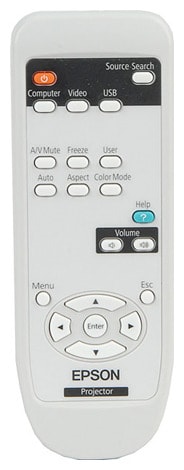
Programming & Flexibility
{{section_header}}{{section.name}}{{/section_header}}
This remote is very simple and cannot be programmed to control other devices.
Input Ports
Wow there is a lot of connectivity back here. You should be able to attach just about any device you have to this projector, with two HDMI ports, a component / composite, two VGA, a USB and an RS232-C plug. There are several audio ports as well, two 1/8th-inch audio in connections and one out. There is space for a microphone as well. We noticed the 12v DC-out plug allowing you to power a smaller device directly from the projector.
One or two absences are worth noting. There is no DVI connection, so Apple users will have to get a VGA or HDMI adapter. This is not a hefty expense, but with so much connectivity Viewsonic could have been friendly and included everyone. But the most curious is the absence of an SPDIF audio out. If you are looking to the use the ViewSonic Pro8200 as a television replacement, then you will probably want to connect a set of external speakers. Most external speaker packages have a digital connection these days so that you can drive HD sound quality from the HDMI port. There are ways around this, but it requires more hardware, like an expensive receiver, that you may not have considered when you bought a projector.
All the ports are listed below.
Other Connections
{{section_header}}{{section.name}}{{/section_header}}
The {{product.model}} has a type A USB port for media connections.
Placement
{{section_header}}{{section.name}}{{/section_header}}
The port layout is simple and well arranged. All connections are on the back, the HDMI ports and the audio connections to the right, with the other video options taking up the left side of the back. All ports are well labeled and arranged in a way that will allow for a multitude of simultaneous connection.
Internet & Media Features
Menus & Manual
{{section_header}}{{section.name}}{{/section_header}}
The menus could be operated by a ape. Not even one of those smart, sign language apes. A lower-rung, remedial math kind of ape. In our experience, that's a good thing. How many times have you seen your boss or teacher fumbling around with a projector's settings? There are not many options to control, and they come in well-labeled columns, done in a consistent layout.
We were surprised to find no paper manual in the {{product.name}} box. Maybe they wanted to save a few trees? In any case, a PDF of the manual can be found here. The organization of information is a little haphazard, but all of the important information as to setup, connections, maintenance, and safety are covered in detail.
Noise
{{section_header}}{{section.name}}{{/section_header}}
The {{product.model}} produced an average of about 42.1 decibels in Brightest mode, and about 38.6 in eco mode. This is pretty quiet for a projector. We did notice that it was a bit louder when we first turned it on, it takes about fifteen minutes to fully warm up and quiet down.
{{image_chart title="Noise", attachment="Noise Graph"}}
Heat
{{section_header}}{{section.name}}{{/section_header}}
In brightest mode, the {{product.model}} shot out some sizzling air particles recorded at 76.6º hotter than the room temperature. This got to be a bit uncomfortable, holding our hand near the exhaust with our temperature gauge. You should give this ViewSonic a good amount of surrounding area to vent. In Eco mode, the temperature difference dropped significantly to 55.8º hotter than the room temperature.
{{image_chart title="Heat", attachment="Heat Graph"}}
Power Consumption
{{section_header}}{{section.name}}{{/section_header}}
In brightest mode, the {{product.model}} consumes an average of 298 watts, costing about $58.19 for a year of average use. Strangely, theater mode uses the most energy, an average of 309 watts, which is what some projectors with a much higher peak brightness consume. This is the setting we recommend you use, especially for the home, so expect to add a little more than $60 to your yearly electricity bill.
{{image_chart title="Power Consumption (modes)", attachment="Power Consumption Modes Graph"}}
{{image_chart title="Power Consumption (calibrated)", attachment="Power Consumption Comparison Graph"}}
Lamp Life
{{section_header}}{{section.name}}{{/section_header}}
The RLC-061 lamp on the {{product.name}} has a great projected lamp life. This is important for projectors because the lamps are expensive and replacement should be budgeted for the predicted life of the bulb. You can expect to get 4,000 hours from this lamp in normal modes, and 6,000 hours in Eco mode.
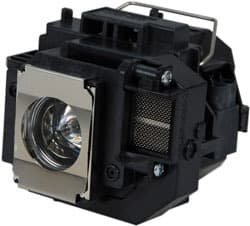
The lamp of the 705HD
Value
{{section_header}}{{section.name}}{{/section_header}}
We like the {{product.name}} over the HD20. They are both 1080p projectors intended as affordable home theater setups. The prices are similar, but the {{product.name}} is cheaper, with a better peak brightness, a host of connectivity, and some good color performance, the value is with the Viewsonic.
Blacks & Whites
{{section_header}}{{section.name}}{{/section_header}}
Though the {{product.name}} had a low peak brightness, it was not as dim as the HD20. The {{product.model}} will prove to be more versatile with this statistic.
{{image_chart title="Contrast", attachment="Contrast Graph"}}
Color
{{section_header}}{{section.name}}{{/section_header}}
Both projectors had perfect color temperature accuracy and similar color curves, as well as color gamuts. The blue values on the HD20 were not as inaccurate as those produced by the {{product.name}}.
Motion
{{section_header}}{{section.name}}{{/section_header}}
The {{product.name}} had better motion performance than the HD20, with fewer visual artifacts in motion.
Viewing Effects
{{section_header}}{{section.name}}{{/section_header}}
The {{product.name}} had a much better throw score than the HD20, making it easier to setup in a variety of situations. The HD20 had a few video processing modes to handle different types of screen materials, adjusting the colors for various materials. The {{product.name}} had no such modes, but we strongly recommend keeping this projector at home with a suitable screen anyway.
Connectivity
{{section_header}}{{section.name}}{{/section_header}}
The {{product.name}} has many more audio connections than the HD20, which may be helpful depending on what you intend to connect.
Value
{{section_header}}{{section.name}}{{/section_header}}
This is an interesting comparison because it demonstrates the difference between features you need for both a presentation projector and a home theater projector. The Epson PowerLite 1775W is compact, has a great peak brightness, a few auto setup modes, and WiFi connectivity. These features provide a versatility and portability that allow for presenting everywhere. It lacks detail in shadow and has less than average color performance. The {{product.name}} is rather large, needs to be setup in low light, and has no such auto setup modes. What it does have is good black and white performance and solid colors, making it a better option for the home theater you have always wanted.
Blacks & Whites
{{section_header}}{{section.name}}{{/section_header}}
The Epson PowerLite 1775W has one of the best peak brightnesses we have seen on a projector. At its brightest, the Epson PowerLite 1775W is almost twice as bright as the {{product.name}}. We did see some serious trouble producing detail in shadows with the Epson PowerLite 1775W, whereas the shadow detail was relatively strong on the {{product.name}}. If you are looking for a home theater setup, we would suggest the {{product.name}} because you can control the light levels in the room and for the superior picture quality. For presentations, the Epson PowerLite 1775W is the clear choice for the peak brightness and portability.
{{image_chart title="Contrast", attachment="Contrast Graph"}}
Color
{{section_header}}{{section.name}}{{/section_header}}
We saw better color performance on the {{product.name}} in all of our testing categories.
Motion
{{section_header}}{{section.name}}{{/section_header}}
The Epson PowerLite 1775W had much better motion performance in both smoothness and artifacting.
Viewing Effects
{{section_header}}{{section.name}}{{/section_header}}
The Epson PowerLite 1775W had a narrow throw range. It is a great projector for meetings because of its easy setup and peak brightness, but you can't set it too far from the screen. On the other hand, it had a couple of modes to deal with different projection materials, like black boards and other non-screen surfaces, which allows for location versatility. The {{product.name}} has a better throw range, but no such material modes, which make it limited to being useful as a home theater.
Connectivity
{{section_header}}{{section.name}}{{/section_header}}
The {{product.name}} has more overall connectivity, including an extra HDMI port and many more audio connections. The Epson PowerLite 1775W on the other hand, has WiFi connectivity built in. This would be a huge boon if you are presenting somewhere and need that internet; not so much if you have a home theater setup.
Value
{{section_header}}{{section.name}}{{/section_header}}
Another Viewsonic model steps into the ring, the PJD5123 challenging the {{product.model}} to a contest of overall value! We see some significant differences between these two: the Viewsonic PJD5123 has a much better peak brightness, almost perfect reproduction of shadow detail and strong color performance, but with a native resolution of 800 x 600, it is clearly not intended as a home theater. The brightness makes it great for general presentation in a variety of environments. The {{product.name}} has a lower peak brightness, but a good overall picture displayed natively at 1080p. These points make it geared towards home theater. You can display a 1080p picture on the PJD5123, but it ain't pretty. If you want a home theater, the {{product.model}} is the way to go.
Blacks & Whites
{{section_header}}{{section.name}}{{/section_header}}
The peak brightness on the PJD5123 gets brighter than the {{product.model}}, and has a better uniformity with this higher brightness.
{{image_chart title="Contrast", attachment="Contrast Graph"}}
Color
{{section_header}}{{section.name}}{{/section_header}}
The color performance was about the same with both of these projectors. The PJD5123 had better color curves, the {{product.model}} had a more accurate color gamut.
Motion
{{section_header}}{{section.name}}{{/section_header}}
The {{product.model}} had better motion performance than the PJD5123 in both the smoothness and artifacting categories.
Viewing Effects
{{section_header}}{{section.name}}{{/section_header}}
With very little zoom, the PJD5123 did not yield a a high throw score. Such a limited zoom makes it a little inflexible in terms of distance, but it should not be counted out as a presentation device. The {{product.model}} had a reasonably good zoom and can be used in a variety of ranges, but after a small amount of distance, it starts to lose a significant amount of brightness.
Connectivity
{{section_header}}{{section.name}}{{/section_header}}
The PJD5123 is not very connectable, especially if you are looking for HD. You can connect a few different monitors if you want to be switching between a few computers. The {{product.model}} on the other hand has many connections, which was quite a boon for this product.
Conclusion
The {{product.name}} ($899 MSRP, slightly cheaper online) is an HD 1080p projector with HDMI connectivity that we peg as best used for home theater. It is not a projector to be used reliably for presentations or in a classroom. The peak brightness is certainly not terrible, but it's also not suited for projecting a large screen in even medium amounts of ambient light. The 1.5x zoom makes for a good throw, but it is short enough to require you to keep the projector close to the screen, which may not be possible in all presentation settings.
We find that if you can keep the projector reasonably close to the screen and in a dark room, you will get a strong 1080p picture with a good set of colors. At this price, a home theater will not break the bank, nor will you have to sacrifice picture quality. Again, keeping the conditions static is key to enjoying the {{product.name}} fully. If you are looking for a cheaper home theater setup, this ViewSonic is a good place to start looking.
Meet the tester
David Kender oversees content at Reviewed as the Editor in Chief. He served as managing editor and editor in chief of Reviewed's ancestor, CamcorderInfo.com, helping to grow the company from a tiny staff to one of the most influential online review resources. In his time at Reviewed, David has helped to launch over 100 product categories and written too many articles to count.
Checking our work.
Our team is here to help you buy the best stuff and love what you own. Our writers, editors, and experts obsess over the products we cover to make sure you're confident and satisfied. Have a different opinion about something we recommend? Email us and we'll compare notes.
Shoot us an email